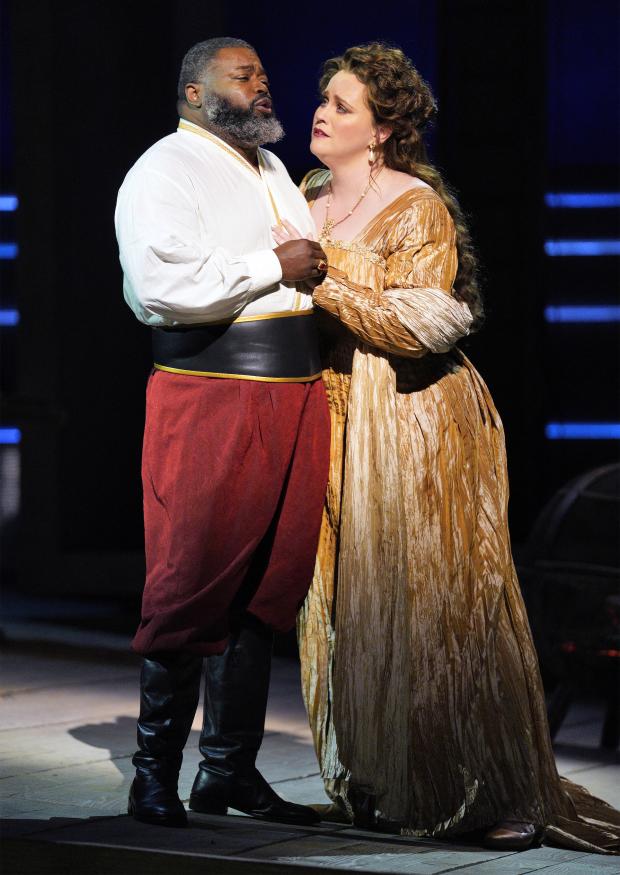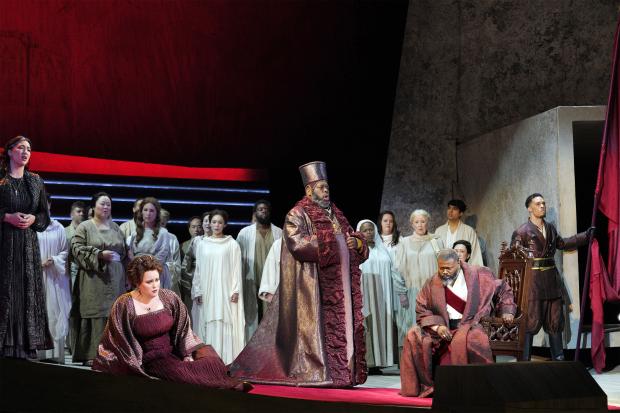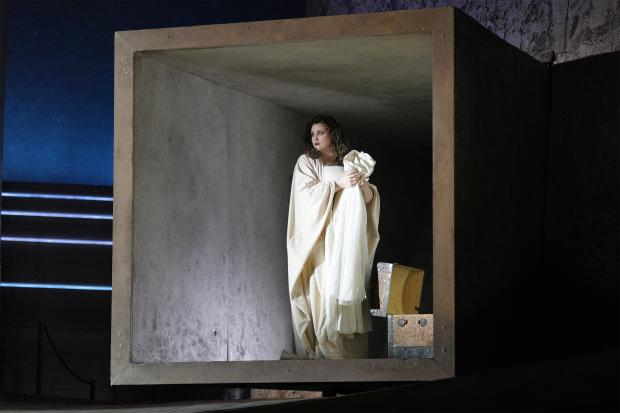Advertisement
As leaders of the Oath Keepers and Proud Boys are convicted of seditious conspiracy for their
roles in the failed Jan. 6 insurrection, LA Opera revives the production about the most malicious
traitor in the entire history of the stage and screen. Sure, Judas betrayed Jesus in The New
Testament and Jesus Christ Superstar, and Major General Benedict Arnold attempted to double-
cross George Washington (and the cause of American liberty) by plotting to turn West Point over
to the British, who he went on to fight for as a counterrevolutionary brigadier general.
But William Shakespeare’s conniving Iago (played to the hilt by Moscow tenor Igor
Golovatanko in Giuseppe Verdi’s operatic adaptation of the Bard’s tragedy) is in a class by
himself when it comes to treachery. For not only does he stab Otello (Miami tenor Russell
Thomas) in the back, he conspires and painstakingly manipulates Otello to be the unwitting
author of the Moor’s downfall, which is carefully choreographed by the scheming Iago every
step of the way. In this specific sense, Iago is more than a mere traitor, he is the puppeteer who
masterfully pulls the strings that leads to Otello pursuing a course of action that causes his own
undoing.
Verdi’s adaptation opens with a raging storm as Otello’s vessel braves the pounding waves and
heaving seas to safely make it ashore at Cyprus to announce a military triumph by the Venetian
forces over the Turkish fleet (ironically, the day I saw Otello, the authoritarian president Recep
Tayyip Erdoğan was reelected in a tight runoff race). This tempest does not appear until Act II of
Shakespeare’s play, as his Act I actually opens in Venice. By Verdi’s cutting to the proverbial
chase, he presents a far more action-packed first act than the Bard did and in so doing provides a
portentous start to this stormy saga about star-crossed and sea-tossed lovers in this opera where
the music ranges from the heady and soaring, to sweet arias lightly sung by Rachel Willis-
Sørenson who plays Desdemona.
Now, in this version of Englishman John Cox’s original production with scenery by South
African Johan Engels, the director of the work currently on the boards at the Dorothy Chandler,
Canadian Joel Ivany, presents what may well be the most visually compelling tableaux I’ve ever
seen in an opera. Deftly utilizing scrims and fellow Canadian Jason Hand’s evocative lighting,
the scene looks like a 3-D movie – except, it really is three dimensional. Most provocative of all
is the angle of the set; indeed, all of the sets seem askew, shown at odd angles, as if to emphasize
how off-kilter this fever dream which Iago plunges poor Otello into is.
I believe the cinematic zest of Act I and all of the subsequent unusual angles of the opera’s
various sets and scenes are due to the iconoclastic influence of that visual virtuoso Orson Welles,
who helmed and played Othello in his 1951 masterpiece. That film won (in a tie) the Grand Prize
at the Cannes Film Festival and the uncanny eye of Orson composed striking compositions of the
picture’s locations, including Venice, elsewhere in Italy and Morocco. The location shooting
looms as a virtual character in his movie. Welles’ classic is full of dazzling optical opulence, and
I sense that Ivany and the Otello team are striving to emulate Orson’s impeccable pictorial
panache with an onstage version of it, rendering some of the finest mise-en-scène this reviewer
has ever seen at an opera.
(Note: Viewers may find it offensive that, despite their stratospheric stature in the arts, the white
thespians Welles, Sir Laurence Olivier in 1965 and Sir Anthony Hopkins in 1981, among others,
portrayed Othello in blackface.)
And what makes the sick Iago tick? Both Shakespeare and Verdi note that Otello the general has,
due to his nautical victory over the Turks, risen in rank to become Governor of Cyprus. But in
doing so, he has in turn overlooked Iago and promoted Cassio instead (Florida tenor Anthony
Ciaramitaro), while Iago remains a mere ensign.
But the astute observer can surmise that something else is afoot besides failing to be promoted.
Sure, this act can inspire treachery – when Nixon failed to make J. Edgar Hoover’s second-in-
command the FBI chief after Hoover’s death, Mark Felt became the celebrated “Deep Throat”
insider source who fed Washington Post investigative reporter Bob Woodward inside info that
helped expose the Watergate break-in and coverup, leading to Nixon’s becoming the first U.S.
president to resign that office.
But in Iago’s case, something else is also afoot: Race. Not only has the Moorish Otello risen in
the military and political ranks of the Venetian Republic, but he has dared (against her father
Brabantio’s express wishes and dire warnings, in Shakespeare’s original) to marry Desdemona
(Washington State soprano Rachel Willis-Sørenson), who is not only years younger than the
Moor (and lusted after by the Venetian gentleman Roderigo, whom Iago likewise hoodwinks and
manipulates, played here by California tenor Anthony León), but is Caucasian.
Thus, what may have propelled Iago to become the dramatic arts’ über-traitor of all time, a
Quisling for the ages, is that he was a white supremacist who objected to Otello and
Desdemona’s true love and interracial marriage. Like LA Opera’s 2023 production of Omar by
Rhiannon Giddens and Michael Abels (see: https://hollywoodprogressive.com/music/new-opera-
opposes-white-supremacy), racism is at the heart of Otello, making this version of Shakespeare’s
circa 1603 play and Verdi’s 1887 opera all too timely. Iago is arguably the prototypical, primal,
ur, white racist of letters.
Although the play and opera is named after the Moorish general, the real protagonist of Otello is
arguably Iago, because with all of his scheming and string-pulling, this traitor is really the
character who is propelling the action forward in the drama. Strangely, during the curtain call
following the three-and-a-half-hour opera with two intermissions, Golovatanko did not join his
fellow cast members and conductor James Connelly onstage to accept their kudos. This clearly
perplexed members of the audience who had wanted to express their appreciation to him for his
fine performance and caused much comment and even consternation.
According to another member of the cast, this was because Igor Golovatanko had recently
performed Otello for students, who booed him during the curtain call. This upset the Muscovite,
as booing performers – even those who play villains – apparently is not the custom in Russia.
The boos are likely also complicated by the current state of tension between Moscow and
Washington, although I presume that most Americans (including this reviewer of Ukrainian
ancestry) do not hold all individual Russians accountable for the war with Ukraine. What
Golovatanko didn’t realize is that booing and hissing of bad guys at the end of a show is aimed at
the character they play, not the artist, and that it is often a way of showing appreciation, in a
lighthearted way, for a stellar performance. It is, in essence, a complement.
Be that as it may, in the denouement there were some unsatisfactory departures from
Shakespeare and perhaps even Verdi in how Otello actually kills Desdemona and where.
Furthermore, Iago heads for the hills, making a getaway, which is definitely not the case in the
Bard’s original. But coming at the end of a tour-de-force, these are mere minor quibbles. Sadly,
Otello marks the last opera of the current season, so to paraphrase Ann-Margret: “Bye Bye,
Verdi!”
This being the case, opera lovers are still in for a treat, as An Evening with Renee Fleming is
being mounted at 7:30 p.m., June 10 (see: https://www.laopera.org/performances/202223-
season/an-evening-with-renee-fleming/).
There are still two performances of LA Opera’s Otello left, at 7:30 p.m., Thursday, June 1 and
Sunday, June 4, at 2:00 p.m. See: https://www.laopera.org/performances/202223-season/otello/
at the Dorothy Chandler Pavilion, 135 N. Grand Avenue, Los Angeles CA, 90012; (213)972-
8001.



